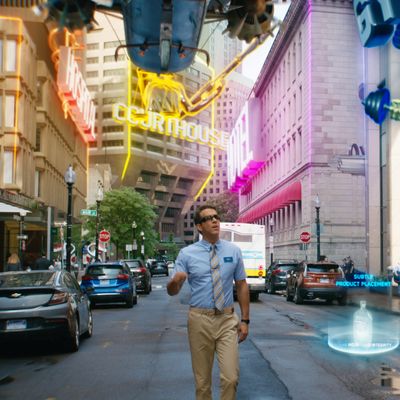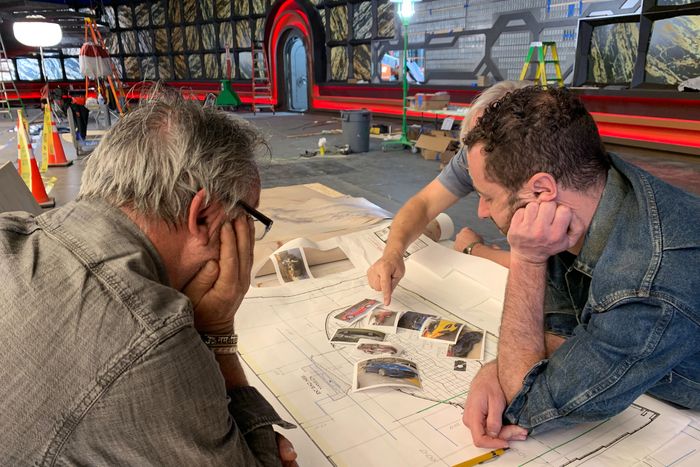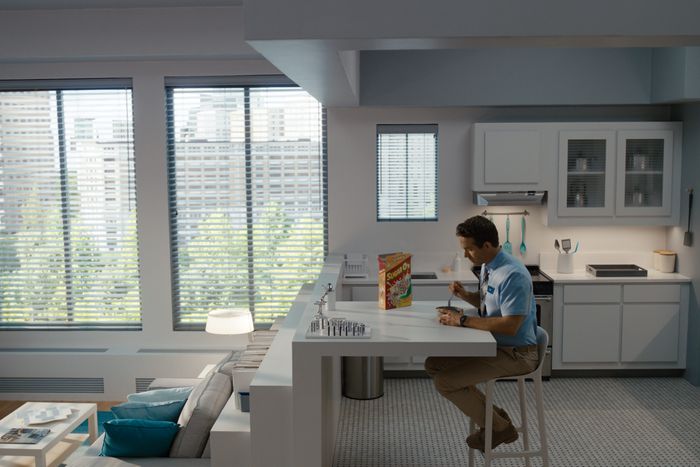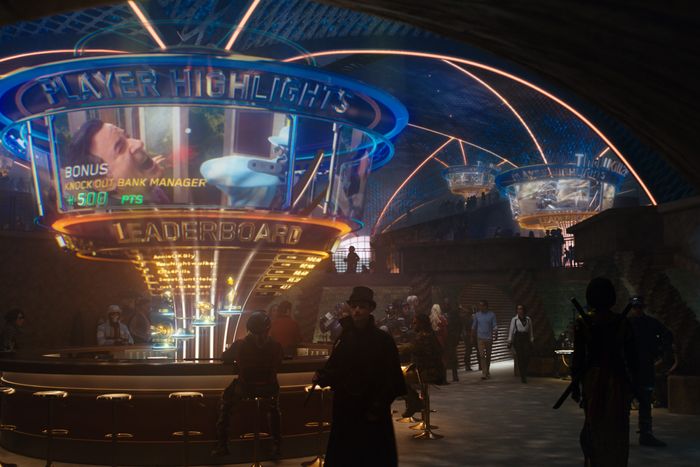
In the action-fantasy-comedy Free Guy, Ryan Reynolds’s character Guy leaps out of bed each morning to cheerily greet the mundanities of life in Free City, where spectacular death lurks around every corner. Helicopters swoop between buildings strafing gunfire, super cars peel through the streets leaving shattered glass and broken bodies in their wake, punk rockers in wraparound shades sucker punch passersby — or they burst into the local bank where Guy works, bazookas a-blazing. Reynolds’s nerdy bank teller, it turns out, is an NPC — a Non-Player Character, or a video game’s version of an “extra” — in a Grand Theft Auto–esque gaming reality. At the outset, our titular also-ran has no idea what separates him from the “sunglasses people.”
For anyone who has spent time behind the controls of GTA, or perhaps Fortnite and Red Dead Redemption, many of the touchstones in Free Guy will be obvious. This computer-generated world pays homage to some of gamerdom’s most iconic titles, where the normal laws of physics don’t apply and not even the pixelated sky is the limit. But according to production designer Ethan Tobman, there are some less obvious details that made their way into Free Guy, culled from famous films and darker visual artworks, that are just as essential to understanding Guy’s inconsequentiality in a realm where surreal mass murder is the only constant. In a conversation with Vulture, Tobman, whose bravura visuals can be seen in Beyoncé’s Lemonade, Formation and Black Is King videos, broke down the many influences and Easter eggs that populate his Free City.
“The idea is like Rosencrantz and Guildenstern Are Dead,” he explains. “You take the most minor, insignificant character and you make the story about him. As a result, he needs to have a fascinating world around him.”
The Inspiration
Within the filmmaking ecosystem, a production designer typically works in tandem with a director, visual-effects team, and cinematographer to calibrate the finer details of a movie — a role old Hollywood referred to as art director. In the case of Free Guy, the Montreal-born Tobman (whose credits include the indie sci-fi Kin and the Best Picture Oscar–nominated Room) worked closely with Shawn Levy and screenwriter Zak Penn. In fact, Tobman and Penn spent days playing video games and spitballing ideas for visual setpieces, including a sequence of a car speeding down a city avenue as buildings crumble in around it, that made its way into Free Guy’s final cut.
The production designer was particularly inspired by Anno, Fortnite (“in terms of the design of the world”), Grand Theft Auto (for its “palette of violence and texture”), Minecraft, and Shadow of the Colossus (for its “lonely” quality). But he reserves special praise for Rockstar Games’ smash-hit action-adventure Red Dead Redemption series, in which players roam the old West on horseback, living and dying by their own self-dictated moral codes. “Video games are so informed by movies. They’re so cinematic and narrative-driven, but now movies are equally inspired by video games,” says Tobman. “Red Dead Redemption was a huge one for me even prior to Free Guy because it really feels like a film noir Western. It has really believable characters that have multiple journeys that you can go on. And none of them are right or wrong.”
Beyond the hours and hours of video-game research, Tobman says he drew inspiration from movies like Blade Runner, Brazil, The Truman Show, and Back to the Future, and leaned into the visual-diarist photography of Stephen Shore and Nan Goldin. “There’s an underbelly to Free City, a dark side,” he says.
The Apartment
Tobman lacked the big-budget experience many of the Marvel-pedigreed PDs competing for the Free Guy gig possessed, but Levy says he was dazzled by the specificity of Tobman’s ideas. For example, Tobman conceptualized Guy’s apartment around a “hilarious intellectual joke” with deep roots in simulation theory: “How do you develop a half-developed character’s base?” asks Tobman. “He literally has a certain amount of gigabytes to economize for a backstory that isn’t important. How does one design an environment for that?”
The answer was found in the tiniest details: Guy’s front door has five deadbolts but no knobs. A calendar on the wall is missing a day of the week. In his pantry — only cereal and a single spoon. And none of the books on his shelf have titles, just a single numeral on each of their spines. “All of these are Easter eggs,” he says. “But that gives you the sense that this person’s life doesn’t matter. We’ve all felt like cogs in the machine that are trying to figure a way out. But maybe we’re not destined for greatness. And that was my way in as the foundation to designing a world.”
The Practical Design
In the film’s opening act, everything changes for Guy when he meets the woman/avatar of his dreams, Molotov Girl (Killing Eve’s Jodie Comer), who mistakes the NPC for a fellow online gamer. She urges him to go from zero to hero by “leveling up” — or defeating other players. It raised certain questions for the filmmakers: “How does Guy level up? How does he fight? What tools does he use to fight? And what are his movements [versus] all of the amazing background characters?”
And so he created his own rules that dictated how and when Reynolds’s character would get run over by a train, careen off the top floor of a building structure encased in inflatable plastic, and get Meet Joe Black-ed between an SUV and a taxi. “Having rules is something you employ to create believable art no matter what the script, no matter what the film,” Tobman explains. And once those rules were established, he knew exactly when to break them — sometimes using practical design.
“What can we do to physically shoot a video game and make you believe it’s happening in the real world?” Tobman asks. Take, for example, when Molotov Girl and Guy infiltrate a Fortress of Solitude–like space filled with cutting-edge weapons and cars (a “stash house”) to recover a key piece of game coding that will help explain the NPC’s miraculous ability to transcend his programming. As outlandishly high tech as the cliffside mansion may appear onscreen, the production constructed its set from IRL materials on an airplane-hangar-sized soundstage outside Boston, including a spiral staircase that employed 40 tons of steel and 100 people to build.
“The stash house is enormous but the idea is, it bends the laws of physics,” he says. “From the outside, you are entering a small space. And once you’re inside, it’s the size of a football field. That’s the joy of a video game. It doesn’t have to follow the rules of gravity or geography. And the fact that they’re presented from the perspective of either teenage boys or filmmakers means that there’s no limits to materials.”
The Gamer Jokes
Levy, the director behind Date Night and the Night at the Museum franchise (who is also the Academy Award–nominated producer of Arrival and Netflix’s Stranger Things), intended for the dense cluster of imagery that makes up Free Guy to only be truly deciphered on a second or third viewing. Meaning there is a glut of blink-and-you-missed-them in-jokes taking place in the periphery of the action-upon-action scenes.
“Shawn had a great idea of having a background character walk into a wall repeatedly because sometimes that’s what happens in video games — you can’t control your person and they keep head-slamming into a non-permeable wall. So we had an extra who did that,” says Tobman. More potentially hilarious to the gaming community: In one scene, a background actor can be seen executing a triumphant yet mocking maneuver known as “tea-bagging.” “Buried deep, deep in the background, a girl’s dancing and sort of repeatedly sitting on someone’s head,” the designer says. “Like, squatting up and down on someone’s head, which is a really common move in video games.”
For one of his own personal favorite hidden jokes, Tobman displays an enviable knowledge of digital nerdery unique to video game R&D. “When they’re escaping down the narrowing avenue, the drawbridge comes up from the highway to help them escape. And beneath that road, there’s sky,” he explains. “Because you don’t develop crust magma in a video game. Why would you develop anything that’s not on camera? You would put a flat road in floating sky. It’s like in The Truman Show: You look behind the curtain and there’s nothing there.”






